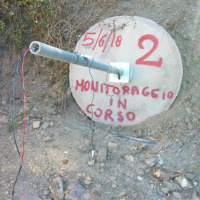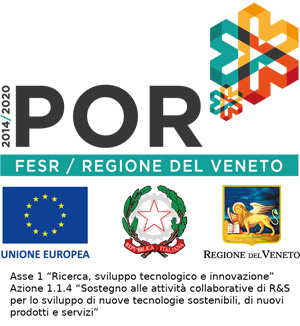Fiber optic sensors engineering for the monitoring of structural reinforcements on unstable slopes
(INMOSTRA)

Background
Geo-Hydrological risks are one of the main sources of economic losses for our country causing a huge number of victims and damages. From 1966 to 2015, landslides and floods caused 1948 casualties, 3524 injured and more than 412,000 displaced people. The Venetian mountain has always been subject to major landslides and, almost every year, new emergencies occur with the intensification of the autumn and spring rains, which are increasing due to the climate change. In this regard, monitoring has a primary role to fulfill the standard requirements and to guarantee the efficiency of the reinforcement works over time, often realized as dayworks. The project proposal aims at the development of an innovative monitoring system of geotechnic reinforcements installed in instability areas. In particular, the project belongs to the Regional Operational Program – European Regional Development Fund (ROF ERDF 2014-2020) of the Veneto Region, “Research and Innovation” ACTION 1.1.4 “Support to collaborative R&D activities for development of new sustainable technologies, new products and services”, and is strongly oriented to industrial development and technology transfer activities.
Purpose
The aim of the project is the implementation of a fiber optic sensor system for distributed monitoring of the mechanical behavior of the reinforcement works used in natural slopes or excavations, to increase the safety of buildings, residential areas and infrastructures concerning phenomena of inherent instability or induced by anthropic action. Specifically, the project has as its objective the engineering of a distributed fiber optic monitoring system of slope reinforcement structures or excavations, capable of:
a) be integrated into the reinforcement structures during the installation phase, to allow preliminary testing of the same;
b) ensure continuous monitoring over time, even remotely, during the life of the reinforcements, providing information on their actual working status and the effectiveness in maintaining the stability conditions of the slope when environmental conditions vary;
c) interface and integrate with other security and / or alert systems.
Methods
The project methodology is carried out on the following activities:
– critical analysis of state of the art;
– reuse of pre-existing relevant data;
– hardware development, based on laboratory experimentation;
– hardware validation in the field;
– quantitative analysis of monitoring data.
Part of these activities flows into the so-called “Observational Method”, according to which, if the knowledge of the site and environmental conditions is not exhaustive, it is possible to define a design solution compatible with the available knowledge and adjust it during the construction phase, upon motivated needs supported by monitoring actions.
Results
The final objective is to integrate fiber optic sensors into the reinforcement system so that they provide accurate information on both the correct installation methods (also for system testing purposes) and their operation, allowing the evaluation of the real behavior of the system. This can be done during the reinforcement implementation but also subsequently, to asses the need for further interventions.
Products
Various technical reports will be produced, relating to the identified query technology, the characteristics of the cable to be integrated into the passive reinforcement, the integration and installation methodology, laboratory calibration, the interpretation of monitoring data, and long-term monitoring.
The results will also be presented at international conferences and publications in peer-reviewed journals will be produced.
Conclusions
The latest generation of fiber optic sensors (FOS) offer many advantages compared to traditional sensors used for slope monitoring, such as: high spatial resolution and precision, large distance between the measurement site and the interrogation unit, flexibility of use, reduced dimensions, durability, low cost of the fiber. Despite this, the use of FOS in slope monitoring is still mainly relegated to the research field, as there are no commercial sensors optimized and standardized for these needs.
Thanks to the combination of the skills of the optical engineer, expert of FOS, the geotechnical engineer, expert of works of arrangement and monitoring of landslides, the numerical modelers and the experts of on-site surveys, it will be possible to develop a systems for monitoring the remediation works for landslides and excavation works. This system will aim at providing the data used to study in detail the remediation works functioning, over time and in relation to weather conditions. Furtermore, it will enable the assessment of the effectiveness of the remediation works and their corrispondence with the project models.








 Internal contact person: luca schenato -
Internal contact person: luca schenato -